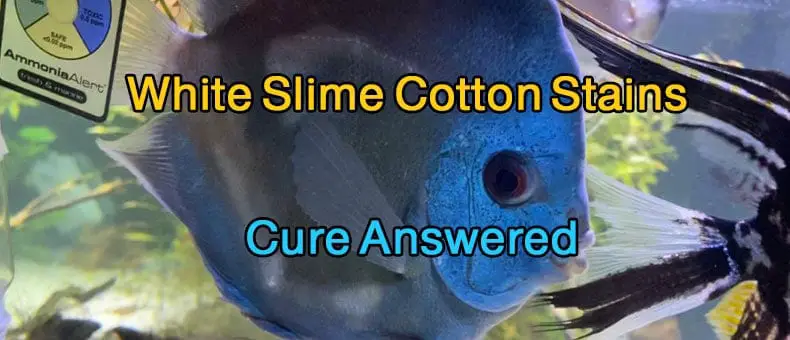
White slime stain is a common fungal infection in discus fishes growing cotton-like stains on their skin. These fungal infections usually found in the aquarium and feed on dead things, discus fish protect themselves through the production of mucus on their bodies forming protective layers and when the layer produced is destroyed, Discus fish can get affected by fungal.
Table of Contents
- What Causes White Fungal Infections?
- Symptoms Of White Cotton Slime Stains
- Treatment Of White Cotton Stains
- Prevention Of Discus White Cotton Stains
- Conclusion
Example of a white slime cotton stain:
What Causes White Fungal Infections?
- Previous infections, injuries, or parasites may cause white cotton stains.
- Physical injury that damages the slime coat and rough handling of discus fish can cause a white cotton lesion.
- Low water temperature- The low water temperature can cause white cotton wool fungus.
- The presence of food remains in the tanks, organic matter, and any other decaying matter increases the probability of infection on Discus.
- Fungus cause cotton-like material is often found on the patches of the fish’s body. This is a secondary bacterial infection that is a sign of damage.
- Low PH levels, this will irritate discus fish skin and might lead to white cottony fungal infection.
Symptoms Of White Cotton Slime Stains
- White cottony stains on the discus body.
- Poor water causes fish to rub against water objects and jumping.
- Discus may turn dark on the skin.
- Presence of excess slime of their body.
- Lack of or reduction of appetite.
- Fins may be clamped with a white cottony coat.
- Discus may be seen darting.
- Discus may hide.
- Tips of the fins may have a whitish coat.
- Presence of fungal or rotting in the tank.
How Do You Treat White Fungus On Discus Fish?
When treating fungal, the following medications are recommended, and in case you cannot find those in the market you may use any anti-fungal fish cure from different companies like Seachem:
Anti Fungus & finrot Medicine
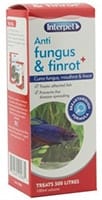
Antifungal and fin rot – used to treat against mouth rot, fin rot, and white slime cotton stains, anti-fungus, and fin rot medicine treat against bacterial and fungal on discus fish and cubs the spread of the disease in your aquarium, hence preventing fish death.
This treatment is best for use in cold water and a tropical aquarium with freshwater, it is also applicable for discus fishes
Disease away medicine
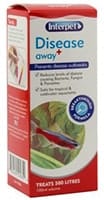
Another medicine used in treating and preventing fungal outbreaks and infections associated with bacteria and infections caused by parasites. Besides, conditions elsewhere can be used to counter infections suspected to be in the aquarium.
Aquarist usually experiences a challenge, especially when conducting general cleaning and addition of new fish. During the process, there can be problems like bullying and stress; as a result, Discus gets stressed up and got prone to infections. In that particular case, you are recommended to use the “disease away” medicine.
Aquarium First Aid Salt Additive
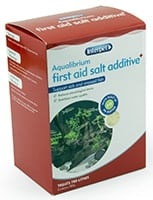
Another medicine used for boosting the immune system of your discus fish to reduce the effects of stress and other impacts associated with medical treatment is the Aquarium First Aid Salt Additive.
You are recommended to use aquarium first aid salt additive with Anti fungal and finrot medicine mentioned above as together can do a better job of removing your discus fungus.
Aquarium Salt Medicine
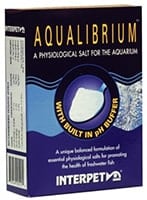
It is a salt’s physiological formula that maintains the balance of the fish freshwater. Notably, it’s useful when Discus fish are stressed or ill so the salt balances in fish are adversely affected, therefore threatening the health of your fish.
Treatment Of White Cotton Stains
In the discus white cottony stains treatment process, you need to apply two treatment steps in order to completely get rid of the white stain fungus, while you have one discus or more infected with fungus then you should consider not only curing the fish but the whole aquarium as well.
[STEP1] – Discus Fish Cottony Stains Fungus Treatment
[STEP1] – Isolate The Discus Fishes
Isolate the fishes in your tank in a new hospital tank with correct water parameters and temperature.
[STEP2] – Use Medications
Apply one of the mentioned medicines as per their instructions:
- Ant fungal and fin rot.
- Disease away.
- Aquarium first aid salt additive.
- Aquarium salt medicine.
[STEP2] – Discus Aquarium Fungus Cleansing
Cleaning your aquarium from fungus is a must when it comes to discus fish keeping, follow the below treatment steps in order to bring back your discus to the tank.
[STEP1] – Try Using Salt
Fungal is intolerance to salts. This is the main reason why fungal infections are never seen in salty water fish. It is recommended to use salt in treating white slime cotton your aquarium to treat and prevent white slime cotton stains.
- Add one tablespoonful of non-iodized salt to each water gallon in aid to treat and prevent white cotton stains.
- Also, use salt in combination with malachite green dye. Aquarist has it that salt has other benefits. It facilitates the reduction of differences between fish’s body fluid and the aquarium water. Salts slow the rate at which fluids are lost from the open lesions.
[STEP2] – Use Potassium Permanganate – Stubborn Fungal Case
For the stubborn fungal, you can use potassium permanganate in countering them. There are bright and vivid formulas and procedures in using the medication. Always follow the manufacturer’s guide and instructions carefully.
Potassium permanganate will paint your aquarium in violet and slowly go away. It is deadly to plants and other biological infections that cause disease. Therefore, treatment using potassium permanganate should be applied in a different aquarium that is free from many organic substances.
[STEP3] – Use Griseofulvin (Fulinex) – Advanced Fungal Extention
When fungal cases are advanced to an extent, the medications mentioned earlier haven’t worked, use Griseofulvin.
- It should be used at the rate of 500 mg Fulvinex tablet in an aquarium with 50 liters of water.
Use methylene blue and various copper formulations. Both will kill plants. However, take caution when using as methylene blue interferes with biological filtration causing a drastic rise in ammonia levels. Also, copper can be toxic when applied to soft water and can cause the death of several invertebrates.
- When using copper, always makes sure that its content is not less than 1mg/l and not more than 1.5 mg/l unless it is in soft water. Follow the manufacturer’s instructions.
Prevention Of Discus White Cotton Stains
- Discuss likes high temperatures than any other fish species, so you ought to maintain the temperature of the tank to certain degrees. Temperatures should be observed in a Discus tank and should range between 82° and 86° F (28º – 31º degrees Celsius).
- Quarantining-quarantining the new incoming discus fish for at least two weeks before introducing them to the existing fish would help to cub white slime stains. Whilst this may not apply to all aquarists, it is worth the investments for you who keep the higher value fish such as a Discus fish, rare fish, and dedicated fish where the use of medication is not recommended.
- Ultra-violent sanitizers-Microorganism causing fungus or disease exists in virtually every aquarium, but of course, it can’t affect fish if their number is kept in low numbers and the fish’s immune system is always good. Ultra-violent sanitizers eliminate microorganisms causing disease as well as algae hence keeping the water healthy and crystal clear.
- Recognition- recognition is one of the skills that every aquarist should have. It’s important to have an understanding of what is normal appearance and behavior of a fish. Observe your discus regularly especially during feeding time. Look for white slime on discus fish. Also, there are things that Discus fish will never do. For instant discus fish don’t usually gasp on the walls.
- Boiling of ornaments- Before introducing new stones and ornaments in the tanks, boil them to kill any parasitic microorganism that may be on the surface.
Conclusion
White slime spots on discus are a common fungal infection occur when you have a bad aquarium tank water quality, it looks like a cottony coat on the discus body and is easy to identify it, once you do, you have to follow the above treatment steps and always focus on the prevention, while it is considered common fungal infection in the discus but it could lead to killing the discus fish if left with no actions.


Thank you for great medical ideas to cure my discus, 👍
Absolutely beneficial to Discus lovers. Thank you very much for dedicating your time to help us all out.